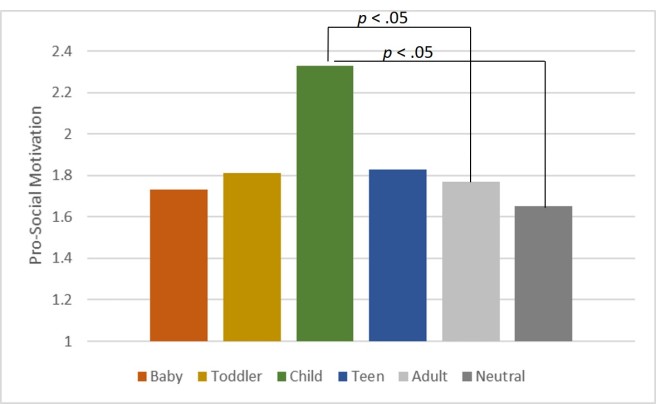In the previous newsletter, we took a first look at what the Child Salience project is about. We highlighted that our main research aim is to test whether thinking about children encourages us to be pro-social (that is, helpful and cooperative) towards others. We also discussed the project background, initial findings from our pilot work and our research questions in more detail.
In this second newsletter, we present very promising findings from our first study, providing a first answer to our question “under which circumstances do children motivate us to be more pro-social?”.
The pilot work suggested that when adults describe what children are typically like, these adults express a higher motivation to be pro-social. That is, a simple 3-5 minutes description task of children encouraged adults to be more considerate of others. While this is a provocative finding that is likely to have widespread societal and personal impact, it is important to replicate this effect in our first study to increase our confidence that it can in fact make a difference. Is the Child Salience effect a reliable effect that we can trust?
Moreover, another aim of Study 1 was to go beyond this finding and identify whether certain child age groups elicit stronger effects than others. For instance, are we more pro-social after thinking about babies than after thinking about older children or teenagers? This may be the case because babies are seen as more innocent and more in need of help and care, and this in turn may motivate us to be considerate of others too.
As you can see in the graph below, Study 1 indeed provided further evidence for child salience effects. We recruited 633 adults for an online study and found that adults who described what a typical child is like (the green bar in the graph below) were more motivated to be pro-social towards others than those who described a typical adult (the light grey bar) or those who skipped this description task (the dark grey bar).

Interestingly, we also found that pro-social motivation was lower in all other child age groups. Adults who described what a typical baby (the orange bar in the graph above), toddler (the yellow bar) or teenager (the blue bar) are like did not show higher levels of pro-social motivation.
While these results from Study 1 increase our confidence in the Child Salience effect, it is more than intriguing that the effect did not emerge for babies and toddlers. This finding suggests that it may not be the described child’s innocence or need of care that drives the effects. After all, babies or toddlers would be expected to be seen as more innocent or more in need of care, and hence we should have found stronger effects when individuals described these groups.
We will explore in future studies why the child salience effect occurs (and why it does not occur for babies and toddlers). We have a few ideas for what may drive these effects, but if you have any ideas or suggestions, we always heartily welcome these in the comments section below!
We will be back in October with our next newsletter!


One thought on “Promising Findings From Study 1”